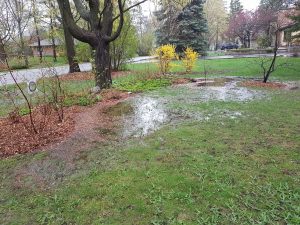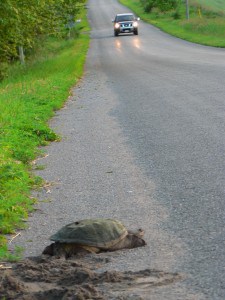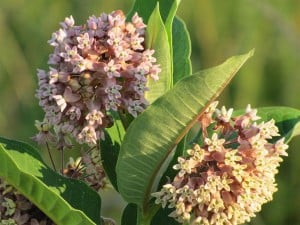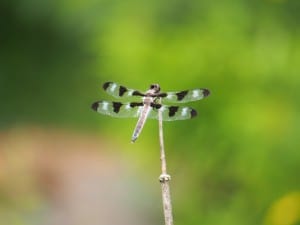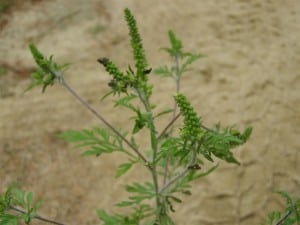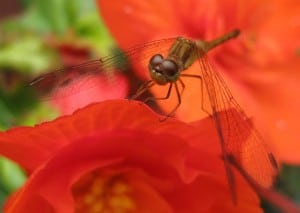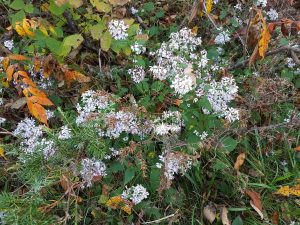Now that summer has officially arrived, I would like to look ahead at some of the events in nature that we can expect over the next three months. The actual timing of events is directly affected by temperature, rainfall, and day length. While these environmental factors obviously change throughout the year, a changing climate is also having an impact on when various happenings in nature occur.
In April, for example, Peterborough received about 1.6 times more precipitation than usual, while in May, this number jumped to 2.3 times the usual rainfall. According to The Weather Network, the summer forecast for central Ontario is pointing towards above-normal precipitation, as well. This, in turn, will probably mean more mosquitoes than usual.
The near-record wet spring and flooding in much of eastern Canada is almost certainly linked to climate change. First, the jet stream — the meandering high altitude winds that flow west to east — is wavier than in the past. It is also moving more slowly and can therefore become locked in place. This means the same weather can persist for weeks on end like we saw with the continuous rain in April and May. Storms, for example, get stuck over a region and don’t move out as quickly as in the past. Meteorologists are linking these changes in jet stream behaviour to a warming Arctic where surface and lower atmosphere temperatures are rising faster than anywhere else on Earth. A warming climate also means that there is more water vapour in the atmosphere. Ocean temperatures are higher, so there is more evaporation and more moist air coming onto the continent from the oceans. The intensity of storms is also increasing because of the energy released from the extra water vapour in the atmosphere.
By keeping track of the dates of happenings such as flowering, bird migration and colour change in leaves, scientists can see how seasonal patterns are changing and thereby make predictions for the future. Already, many flowering dates are happening earlier on average. The following is a list of events in nature that are typical of summer in the Kawarthas.
Late June
· Turtles can still be seen along roadsides and rail-trails laying their eggs. Please slow down in turtle-crossing zones and, if it is safe, help the animal across the road.
· Monarch butterflies have returned – the “grandchildren” of those that flew to Mexico last fall. Local monarch numbers appear quite good so far this year. Make sure you have some milkweed in your garden on which they can lay their eggs.
· Is your garden a haven for bees, butterflies and other pollinators? If so, please take a moment to register your garden in the Peterborough Pollinators 150 Garden Challenge. The group’s goal is identify a network of 150 existing & new pollinator gardens in the Peterborough area to help celebrate Canada’s sesquicentennial birthday. Go to peterboroughpollinators.com/Register/

Be sure to register your pollinator garden in the Peterborough Pollinators 150 Garden Challenge – Drew Monkman
· All of the rain we’ve had has created extensive breeding grounds for mosquitoes. We may be looking at a buggier than normal summer.
July
· Common milkweed is in flower and its rich, honey-sweet perfume fills the early summer air. The scent serves to attract insects whose feet will inadvertently pick up the flowers’ sticky pollinia – small packets containing pollen – and transfer them to another plant. If the insect is not strong enough, however, it can actually become stuck to the pollinia and die.
· A huge number of other plants are blooming, as well. In wetland habitats, watch for common elderberry, swamp milkweed, Joe-Pye weed, yellow pond lily and fragrant white water lily. Along roadsides and in meadows, watch for ox-eye daisy, yarrow, viper’s bugloss, black-eyed Susan, Queen Anne’s lace, wild bergamot, purple-flowering raspberry and orange hawkweed – to name a few.
· July is a great time to turn your attention to butterflies. Although these colourful insects can be found just about everywhere, Petroglyphs Provincial Park and Sandy Lake Road south of Lasswade are two of the best locations for less common species like skippers and hairstreaks.
· It is hard to go anywhere near water in July and not notice dragonflies and damselflies. Some even turn up in suburban gardens. To tell them apart, remember that dragonflies have thick bodies, are strong fliers, and their wings are open at rest. Damselflies are usually much smaller, have thin bodies, are weak fliers, and their wings are closed or only partially spread at rest. Some of the most frequently seen damselflies are powder-blue in colour, hence the common name of “bluets.” As for dragonflies, some common species include the dot-tailed whiteface, common whitetail, twelve-spotted skimmer and chalk-fronted skimmer. Go to odonatacentral.org/ for pictures of all Ontario dragonflies and damselflies. Click on “checklists” and then type “Ontario” in the search box.
· By mid-July, the buzzy, electric song of the dog-day cicada fills the void created by the decrease in bird song.
· Watch for mushrooms such as white pine boletes and fly agarics. Summer – not fall – usually produces the greatest variety of species. With all the rain we’ve had this year, mushrooms should be more abundant than usual.
August
· Listen for the high-pitched “lisping” calls of cedar waxwings and the “po-ta-to-chip” flight call of the American goldfinch. Watch for waxwings on the branches of dead trees along the River Road between Trent University and Lakefield. They sally out from these branches to catch insects on the wing.
· A large percentage of the insect music we here this month comes courtesy of crickets and katydids. For example, the soft, rhythmic “treet…treet…treet” of the snowy tree cricket sounds like a gentle-voiced spring peeper. Its beautiful rhythmic pulsations actually provide a good estimate of air temperature. Watch and listen at bit.ly/18nGrJ3
· By mid-August, ragweed is in full bloom and its pollen has hay fever sufferers cursing with every sneeze. Goldenrod, which relies on insects to spread its sticky, heavy pollen, is not the culprit. The small, green flowers of the ragweed, however, rely strictly on the wind to spread the ultra light, spike-covered pollen grains. Research done by the U.S. Department of Agriculture has shown that over the past four or five decades the higher CO2 levels associated with global warming may have doubled the amount of pollen that ragweed is producing.
· Small dragonflies known as meadowhawks abound. Mature males are red, while females and immature males are yellowish. They are common in suburban gardens.
· Cottagers sometimes find large, mysterious, jelly-like “blobs” attached to the dock or aquatic plants. They are formed by colonies of Bryozoa, a freshwater invertebrate. Looking somewhat like an egg mass, the clumps are clear, dense, and have distinct, repetitive patterns and markings on the outside. Bryozoa are like a freshwater coral in that the mass they form is actually a colony of thousands of zooids – roughly analogous to polyps in corals. Each tiny zooid has whorls of ciliated feeding tentacles that sway back in forth to catch plankton in the water.
· Songbird migration is in full swing by late August, with numerous warblers, vireos and flycatchers moving through. These birds can easily be attracted by pishing. If you see or hear chickadees in late August, you can usually assume that migrants will be with them.
· Goldenrods reach peak bloom at month’s end and become the dominate flowers of roadsides and fields. These plants are veritable insect magnets, drawing in an amazing variety of species with their offerings of pollen and nectar.
September
· Monarch butterfly numbers are at their highest. Monarchs congregate at peninsulas on the Great Lakes such as Presqu’ile Provincial Park, a jumping off point for their migration across Lake Ontario and on to Mexico. A monarch tagging demonstration will be held on the afternoon of September 2 and 3. Monarch expert Don Davis will be on hand to answer questions and to show how the butterflies are tagged with a tiny adhesive sticker bearing a number and return address. You will even have the chance to release a tagged butterfly! There will also be bird-banding demonstrations and guided nature walks. Go to friendsofpresquile.on.ca for more information.
· Large mating swarms of winged ants are a common September phenomenon, especially on warm, humid afternoons. Some are females – the potential future queens – but the majority are males. Ants bear wings only during the mating season.
· Two species of white-flowered vines are very noticeable, especially along woodland edges where they sprawl over fences, shrubs and trees. They are wild cucumber, which develop into roundish, cucumber-like seed pods covered in soft bristles, and Virgin’s bower, identified by its distinctive, fluffy seed heads of gray, silky plumes.
· By late September, the purples, mauves, and whites of asters reign supreme in fields and along roadsides and represent the year’s last offering of wildflowers. The most common species include New England, heath, panicled and heart-leaved asters.
· Be sure to put your bird feeders up this month. If you scatter millet or finch mix on the ground, you should be able to attract white-throated sparrows which migrate south in late September.
· A bumper crop of spruce cones may bring birds such as white-winged crossbills into central Ontario.
· Most years, Virginia creeper vine, poison ivy, choke cherry and staghorn sumac reach their colour peak at about the fall equinox, which occurs this year on September 22.
